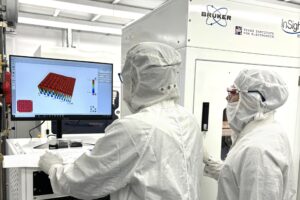AUSTIN, Texas—A University of Texas at Austin microelectronics researcher has received $500,000 from the Department of Defense to research ways to use nanotechnology to overcome hurdles that might halt the march of the silicon-based integrated circuit.
The money will be used to buy new equipment, provide research assistantships to undergraduate and graduate students and help fund a work force development project to train semiconductor technicians with Austin Community College (ACC), said Dr. Sanjay Banerjee, director of the Microlectronics Research Center at The University of Texas at Austin and a professor in the Department of Electrical and Computer Engineering in the College of Engineering.
“With the University of Texas and a large high tech sector in my district, I am going to do everything I can to support their efforts in cutting edge research and technological innovation,” said U.S. Rep. Michael McCaul, who represents the 10th District of Texas.
Banerjee said McCaul has proven to be a staunch supporter of research and higher education in Texas, and an effective spokesman for Texas in Congress.
“The Microelectronics Research Center is extremely grateful to him for this critical support at a time of dwindling research dollars,” Banerjee said.
The roadblocks to continued progress of the silicon-based processor have been identified by the International Technology Roadmap for Semiconductors, an international cooperative effort of the global semiconductor manufacturers and suppliers, government organizations, consortia and universities. Banerjee is on this advisory committee.
Conventional semiconductor technology has grown from putting dozens of transistors on a circuit to putting a billion on them today. That has increased their speed and capacity for computation. However, the physical capacity of the materials and methods used to design and manufacture these processors are reaching their limits. This workhorse technology for making integrated circuits is called complementary metal oxide semiconductor (CMOS) technology.
Rather than replace CMOS, Banerjee proposes integrating it with compatible nanoelectronic devices, materials and processes that will extend the technology’s life.
Banerjee and the Microelectronics Research Center (MRC) will work to develop new structures and materials that will reduce power dissipation in integrated circuits, increase speed and achieve higher packing density. Also, they will work on novel interconnect devices to make sure that high-performance circuits aren’t bottlenecked as they exchange information with other computer devices. The MRC will test the devices and materials by running simulations.
Banerjee said a portion of the $500,000 would go toward the MRC’s technician training program with ACC. The trainees get a stipend for a one-year internship in the final year of their study.
“We would like to continue this program and extend it to other schools in central Texas,” Banerjee said.
For more information contact: Tim Green, The University of Texas at Austin, 512-475-6596; Jack Hirschfield, Rep. McCaul’s office, 202-812-0654.



